The gravelly outwash prairies of South Puget Sound provide habitats for a variety of animals that are not commonly found in western Washington. All of the species listed here show evidence of decline and some may be relict populations from a time when they were possibly more widely distributed over Washington’s landscape. Threats to these species include introduced plants such as Scot’s Broom, land development, overgrazing, and the natural succession of prairie landscapes to forest. As prairie habitat disappears- through conifer encroachment and human activities- so will these species that are living clues to our region’s geological and climatic history.
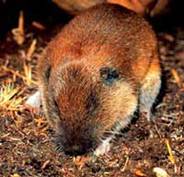 Mazama Pocket Gopher (Thomomys mazama) Mazama Pocket Gopher (Thomomys mazama)
Mazama (or Western) Pocket gophers are rodents that spend most of their lives underground, and are particularly well-adapted for burrowing. They have short, strong legs, and small ears and eyes. Their lips can be closed behind their front incisors, which the gophers use for burrowing. Their soft, loose pelts enable them to move backwards through their tunnels as easily as they move forwards. Each pocket gopher also has two, fur-lined check pouches extending from the lower portion of its face to its shoulders. These pouches are used to transport food, and can be turned completely inside out.
Pocket gophers feed on roots, bulbs, tubers, and the leafy portions of plants. They often forage by biting off a plant’s roots, and then pulling the entire plant down into the burrow from below. This strategy helps limit time spent above ground. Pocket gopher burrows are usually marked by a series of earth mounds. Unlike mounds created by moles, which are volcano-shaped, pocket gopher mounds are fan-shaped. Pocket gopher burrows have separate chambers for food storage, nests, and waste.
In western Washington, several isolated populations of pocket gophers have evolved into separate subspecies. Some of these subspecies are already extinct, and the rest have become rare. Habitat alteration, the use of traps and poisons, and predation by domestic pets, all take their toll on this species. The Mazama Pocket Gopher is a State Candidate Species, and has been proposed as a Federal Candidate Species.
The Oregon Vesper Sparrow (Pooecetes gramineus affinis)
The Oregon Vesper Sparrow is a rare and declining local race which inhabits western Washington prairies. It is a light-colored sparrow with buffy-brown streaks on the crown and throat, black back feathers, a rusty patch on the shoulder and white outer tail feathers. This ground-nesting bird feeds primarily on insects and seeds. It is vulnerable to predators including domestic pets. These birds winter n the central California valleys south to Baja.
This race is in danger of extirpation in Washington due to conversion of prairies to residential areas, farmland, and shrub fields of non-native Scot’s Broom and forest (due to fire suppression). In the past, there was confirmed breeding among populations at Dungeness and Port Angeles, but those populations may now be extirpated. Stable populations exist on San Juan Island and the Fort Lewis/McChord Air Force Base/Yelm area. Nine recent breeding locations are known with small populations near Shelton, on the Scatter Creek Wildlife Area and the Mima Prairie. The Oregon Vesper Sparrow is a State Candidate Species.
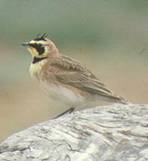 Streaked Horned Lark (Eremophila alpestris strigata) Streaked Horned Lark (Eremophila alpestris strigata)
Though other subspecies of horned larks can be found in open areas of eastern Washington and above the tree line in the mountains, the Streaked Horned Lark resides west of the Cascades at low elevations, from southern British Columbia to Oregon. This small, ground-dwelling bird has dark tufts of feathers on the back of its head. It has a brown back and neck, yellowish under parts, and a yellow eyebrow stripe and throat.
Horned larks prefer sparsely vegetated prairies and agricultural land with short vegetation. These birds forage for seeds and insects on the ground. Horned larks form nomadic foraging flocks during fall and winter, but establish territories when breeding. Its nest consists of a depression on the ground, lined with fine plant fibers woven with soft material such as feathers, fur, and rootlets. This lark most often sings in flight, circling slowly on fluttering wings so high in the sky that it can be difficult to spot. Less commonly, it will sing from high points on the ground. Its primary song during the breeding season is a lengthy series of tinkling notes that seemingly come drifting down from the far reaches of the sky.
Historical evidence suggests that this subspecies has declined considerably in abundance since the days when prairies were more extensive in western Washington. The Streaked Horned Lark is a State Candidate Species in Washington.
For more information about the streaked horned lark, visit the technical documents page.
Mardon Skipper (Polites mardon)
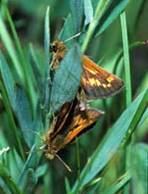 This small, orange butterfly occurs on the Tenino Prairies of Thurston County, Washington, and can also be found in the south-central Cascades, where it inhabits ridge tops and other openings within Ponderosa Pine woodlands. The Mardon Skipper has been found in less than ten locations in Washington, but is often numerous where it occurs. It is thought to depend upon Idaho Fescue (Festuca idahoensis) as a larval host plant, and uses a variety of spring-flowering nectar sources, including the Western Blue Violet (Viola adunca). The Mardon Skipper is a State Candidate Species and proposed Federal Candidate Species, and exists primarily in Washington. One record exists for this species in southwest Oregon, and it has also been found on serpentine deposits in northwestern California. This small, orange butterfly occurs on the Tenino Prairies of Thurston County, Washington, and can also be found in the south-central Cascades, where it inhabits ridge tops and other openings within Ponderosa Pine woodlands. The Mardon Skipper has been found in less than ten locations in Washington, but is often numerous where it occurs. It is thought to depend upon Idaho Fescue (Festuca idahoensis) as a larval host plant, and uses a variety of spring-flowering nectar sources, including the Western Blue Violet (Viola adunca). The Mardon Skipper is a State Candidate Species and proposed Federal Candidate Species, and exists primarily in Washington. One record exists for this species in southwest Oregon, and it has also been found on serpentine deposits in northwestern California.
Puget Blue (Plebejus icarioides blackmorei)
This delicate blue butterfly, which occurs only on the south Puget and Sequim prairies in Washington, is a State Candidate Species. These butterflies are colonial and usually rare. Their host plant is lupine which thrives in habitats such as prairies, forest clearings, power line and railroad rights-of way. Many localized populations of the Puget Blue and other grassland butterflies have been lost because of development, grazing, and the use of herbicides and pesticides. Efforts to moderate the impact of these activities on natural habitats will benefit the diversity and abundance of our entire butterfly fauna.
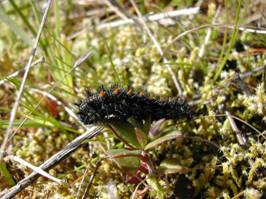
Taylor’s Checkerspot (Euphydryas editha taylori)
This black, white and orange patterned checkerspot is one of the more colorful prairie butterflies. It occurs in the Puget prairies and the maritime prairies along the Straits of Juan de Fuca and the San Juan Islands. The host plants include the native and introduced plantain. Light grazing or burning may favor plantain and thus benefit the butterfly. The Taylor’s Checkerspot is a State Candidate Species. Because the prairie butterfly populations are declining, collectors should avoid collecting these rare species.
Western Fence Lizard (Sceloporus occidentalis)
The lizard is usually some shade of gray or brown and grows to 6.6 inches in length. They occur in scattered localities around Puget Sound, along the east slope of the Cascades and the Blue Mountains. In the Puget Trough, they prefer the drier habitats such as grasslands, clearings, and recently logged areas where thy feed on insects and other small invertebrates. This reptile emerges from hibernation in spring, when males can be observed displaying on elevated perches such as rocks, logs and stumps. They can also be seen scampering up tree trunks and across rocky or gravelly areas. This lizard has been declining in the Puget Trough for, as yet, unknown reasons.
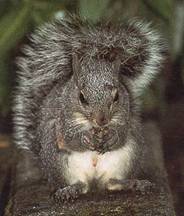 Western Gray Squirrel (Sciurus griseus) Western Gray Squirrel (Sciurus griseus)
This Western Gray Squirrel is the only large gray tree squirrel occurring in its range along the West Coast region. It is gray with numerous white-tipped hairs on its back and a white belly. The backs of its ears are a reddish brown, and it has a long, bushy tail with bands of gray, white, and black, especially noticeable along the tails underside. This species remains active year round, though during particularly bad storms it may seek shelter in its nest. In summer it uses a nest of shredded bark and sticks, usually placed at least 20 feet above the ground; in winter, it most likely lives in a tree hollow. This gray squirrel feeds primarily on pinecones, acorns, and other nuts, and will eat some fungi, berries, and insects. This squirrel's hoarse barking call is heard mostly in the late summer months.
The Western Gray Squirrel has been found in three areas in Washington State , including the South Sound region. It relies heavily on the oak prairie woodlands, a habitat that is under assault from population growth and development. This loss of habitat has drastically reduced the number of Western Gray Squirrels in the state. This squirrel is a State Candidate Species.
Additional Rare or Declining Prairie Wildlife
Several other butterflies are restricted to Puget prairies. Each prairie will have a unique assemblage of butterflies, that may include the Zerene (or Valley) Silverspot (Speyeria zerene bremnerii) or the Oregon Branded Skipper (Hesperia comma oregonia). Puget prairies are also a preferred habitat of one of our largest butterflies, the Puget Sound Silverspot (Speyeria cybele pugetensis).
The Slender-billed White-breasted Nuthatch (Sitta carolinensis aculeata) is a western Washington subspecies that is very local, rare and seriously declining. It is associated with oak and oak-conifer woodlands in the southern Puget Trough and in the Vancouver plains in Clark County.
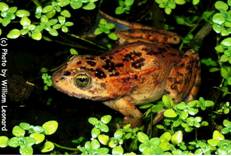
Two reptiles, the Pacific Gopher Snake (Pituophis melanoleucus catenifer) and the Racer (Coluber constrictor), have been extirpated from the prairies and the Sharp-tailed Snake (Contia tenuis) is declining. The Western Pond Turtle (Clemmys marmorata) and the Oregon Spotted Frog (Rana pretiosa), both endangered species, are associated with prairie wetlands. |



